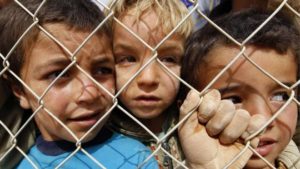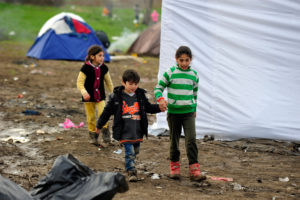Child refugees at risk – UN report
Almost 50 million children are now displaced across the globe with 28 million of them driven from their homes by conflict, according to a new report from UNICEF.
Millions more are migrating in the hope of finding a better and safer life, the UN’s children’s welfare agency says.
The report, titled Uprooted: The growing crisis for refugee and migrant children, says that child refugees, often traumatised by the conflicts and violence they are fleeing, face further dangers along their journey including the risk of drowning on sea crossings, malnourishment and dehydration, trafficking, kidnapping, rape and even murder.
 “In countries they travel through and at their destinations, they often face xenophobia and discrimination,” the report says.
“In countries they travel through and at their destinations, they often face xenophobia and discrimination,” the report says.
It presents new data that paints a sobering picture of the lives and situations of millions of children and families affected by violent conflict and other crises; events that make it seem safer to risk everything on a perilous journey than remain at home.
The report says Europe hosts approximately one in nine of the world’s refugees, a total of 1.8 million people. By the end of 2015, an additional one million asylum-seekers in Europe were also waiting for a decision on their asylum applications.
It says children make up 31 per cent of all refugees and migrants who have arrived by sea in 2016, and around 45 per cent of those stranded in south-east Europe. In addition, out of the 1,886,000 first time asylum applications registered in Europe during the last 18 months, 43 per cent (or 810,000 applications) were by children.
“Children represent a disproportionate and growing proportion of those who have sought refuge outside their countries of birth: they make up about a third of the global population but about half of all refugees. In 2015 around 45 per cent of all child refugees under UNHCR’s protection came from Syria and Afghanistan,” the report says.
“Twenty-eight million children have been driven from their homes by violence and conflict within and across borders, including 10 million child refugees; 1 million asylum seekers whose refugee status has not yet been determined; and an estimated 17 million children displaced within their own countries – children in dire need of humanitarian assistance and access to critical services,” it says.
The report says the number of children crossing borders unaccompanied are increasing. In 2015, more than 100,000 unaccompanied minors applied for asylum in 78 countries – triple the number in 2014.
 Unaccompanied children are among those at the highest risk of exploitation and abuse, including by smugglers and traffickers, it says.
Unaccompanied children are among those at the highest risk of exploitation and abuse, including by smugglers and traffickers, it says.
About 20 million other international child migrants have left their homes for other reasons including extreme poverty and gang violence with many at risk of abuse and detention because they have no documentation, the report says.
It reveals there is no systematic tracking and monitoring of child refugees’ wellbeing.
According to the report, Turkey hosts the largest total number of recent refugees fleeing to Europe, and very likely the largest number of child refugees in the world.
UNICEF UK Deputy Executive Director Lily Caprani said the numbers of lone child refugees were unprecedented.
“Today, nearly one in every 200 children in the world is a refugee. In the last few years we have seen huge numbers of children being forced to flee their homes, and take dangerous, desperate journeys, often on their own,” Ms Caprani said.
“Children on the move are at risk of the worst forms of abuse and harm and can easily fall victim to traffickers and other criminals.”
The report argues that where there are safe and legal routes, migration can offer opportunities for both the children who migrate and the communities they join.
Several analyses of the impact of migration in high-income countries have found that migrants contributed more in taxes and social payments than they received; filled both high- and low-skilled gaps in the labour market; and contributed to economic growth and innovation in hosting countries.
But, crucially, children who have left or are forcibly displaced from their homes often lose out on the potential benefits of migration, such as education – a major driving factor for many children and families who choose to migrate, the report said.
It said a refugee child was five times more likely to be out of school than a non-refugee child. When they are able to attend school at all, it is the place migrant and refugee children are most likely to encounter discrimination – including unfair treatment and bullying.
Outside the classroom, legal barriers prevent refugee and migrant children from receiving services on an equal basis with children who are native to a country. In the worst cases, xenophobia can escalate to direct attacks. In Germany alone, authorities tracked 850 attacks against refugee shelters in 2015, the report said.
It made six specific recommendations to protect and help displaced refugee and migrant children:
• Protecting child refugees and migrants, particularly unaccompanied children, from exploitation and violence.
• Ending the detention of children seeking refugee status or migrating by introducing a range of practical alternatives.
• Keeping families together as the best way to protect children and give children legal status.
• Keeping all refugee and migrant children learning and giving them access to health and other quality services.
• Pressing for action on the underlying causes of large-scale movements of refugees and migrants.
• Promoting measures to combat xenophobia, discrimination and marginalisation.
Laurie Nowell
AMES Australia Senior Journalist












